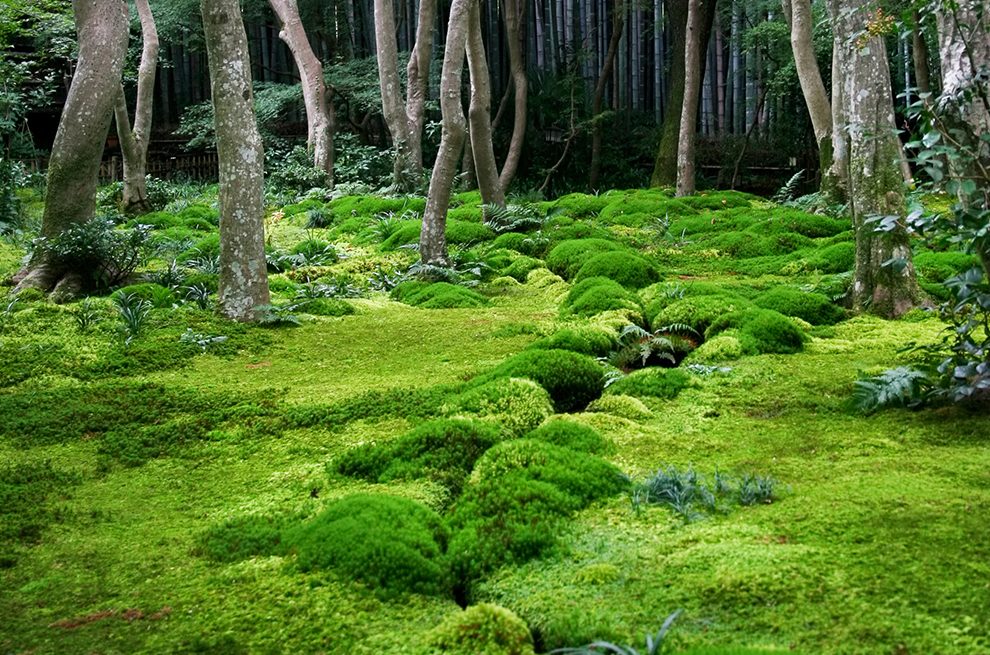Mossin’ Annie and Some Moss Garden Wisdom
The Laurel of Ashville, a moss garden featured in Annie Martin’s book, The Magical World of Moss Gardening
By Thomas Christopher
I spoke to a remarkable gardener yesterday – Annie Martin, or as she prefers to be known, “Mossin’ Annie.” Based in Pisgah Forest, in the Appalachian Mountains of western North Carolina, she operates a moss garden design and installation service.
What she creates are rare intersections of natural beauty and environmental benefit.
I don’t have to praise the beauty of moss gardens to anybody who has seen one. If you have, that probably occurred on a visit to an authentic Japanese garden, such as the John P. Humes Japanese Stroll Garden in Mill Neck, New York. That garden boasts a moss lawn and much use of moss throughout the landscape. The plush textures of the moss and the infinite range of rich greens make such displays unforgettable. It’s worth noting that greens, although the primary colors of mosses, aren’t the only ones. As Annie Martin points out in her book,The Magical World of Moss Gardening (Timber Press, 2015), seasonally and in areas of brighter light, mosses can also blush red, orange, or golden.
Interestingly, Annie says that she doesn’t believe that the famous moss gardens of Japan were originally planned and planted as such. Rather, the mosses first appeared in these landscapes uninvited. Any gardener who has battled moss in the lawn knows that this spore-bearing plant can appear seemingly from nowhere and can also be quite persistent. The genius of the Japanese gardeners lay in the fact that they accepted the mosses’ arrival and chose to cultivate these plants rather than fighting them.
Mosses are primitive plants – indeed, Bryophytes, the group that includes them, were the first land plants, appearing some 450 million years ago. As such, they developed the ability to inhabit what might seem to be inhospitable habitats. They can grow on the poorest of compacted soils or even bare rock, and they flourish virtually everywhere there is sufficient moisture, from the tropics to Antarctica.
This makes mosses ideal for disturbed, unpromising areas of the landscape: spots too shady or too compacted to grow grass or flowers. But mosses are much more than a last resort: their unconventional beauty and practicality makes them ideal for a feature in some prominent spot where the moss garden can be enjoyed on a regular basis, as in the view from a terrace or deck.
Mosses don’t demand much. There’s no need for chemicals when growing mosses. They find their nutrients in the dust that settles out of the air, so they have no need for fertilizers. They are naturally pest resistant, so don’t need pesticides. Weeding the moss garden is a necessity, especially in the planting’s early years, but this is best done by hand rather than with herbicides. A moss garden must be kept moist – a light sprinkling once or twice a day is ideal – but they don’t require the kind of deep watering that a lawn requires. To thrive, mosses must be kept clear of falling leaves and other debris. A careful sweeping is sufficient for that; if your moss garden is well established, an electric blower wielded sensitively will do the job more quickly and easily.
There are a couple of ways to establish moss on your selected site and Mossin’ Annie goes into considerable detail on this subject in her book. You can create a favorable habitat of compacted substrate, keep it moist, and wait for the mosses to colonize on their own, but that is only for the very patient. Alternatively, you can install a patchwork of mature mosses, or you can shred moss clumps, scattering the fragments over the area to be planted and then stepping on them to firm the fragments in place.
The most controversial aspect of moss gardening is where and how you obtain your planting material. Mossin’ Annie grows mosses from fragments and supplies the resulting sheets to her clients, even selling them by mail order. She also rescues mosses (always with the permission of the owners), from roofs and even parking lots that are about to be renewed, and from moss-grown land that is about to be developed for new construction. What she decries, and what is unfortunately all too common, is the theft of mosses from public forests and parks. According to Mossin’ Annie, this practice is common among commercial suppliers of moss plants, and ethical customers should investigate the supplier’s source before placing an order.
Thomas Christopher is the co-author of “Garden Revolution” (Timber Press, 2016) and is a volunteer at Berkshire Botanical Garden. berkshirebotanical.org
Be-a-Better-Gardener is a community service of Berkshire Botanical Garden, one of the nation’s oldest botanical gardens in Stockbridge, MA. Its mission to provide knowledge of gardening and the environment through 25 display gardens and a diverse range of classes informs and inspires thousands of students and visitors on horticultural topics every year. Thomas Christopher is the co-author of Garden Revolution (Timber press, 2016) and is a volunteer at Berkshire Botanical Garden. berkshirebotanical.org.




